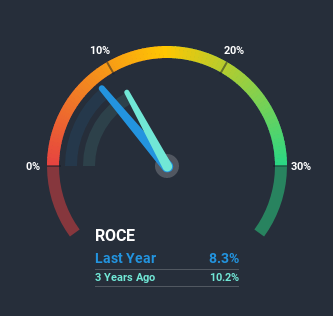- Taiwan
- /
- Semiconductors
- /
- TWSE:3532
Has Formosa Sumco Technology (TPE:3532) Got What It Takes To Become A Multi-Bagger?
There are a few key trends to look for if we want to identify the next multi-bagger. Firstly, we'll want to see a proven return on capital employed (ROCE) that is increasing, and secondly, an expanding base of capital employed. This shows us that it's a compounding machine, able to continually reinvest its earnings back into the business and generate higher returns. However, after briefly looking over the numbers, we don't think Formosa Sumco Technology (TPE:3532) has the makings of a multi-bagger going forward, but let's have a look at why that may be.
Understanding Return On Capital Employed (ROCE)
Just to clarify if you're unsure, ROCE is a metric for evaluating how much pre-tax income (in percentage terms) a company earns on the capital invested in its business. The formula for this calculation on Formosa Sumco Technology is:
Return on Capital Employed = Earnings Before Interest and Tax (EBIT) ÷ (Total Assets - Current Liabilities)
0.083 = NT$1.7b ÷ (NT$22b - NT$1.6b) (Based on the trailing twelve months to September 2020).
Therefore, Formosa Sumco Technology has an ROCE of 8.3%. On its own, that's a low figure but it's around the 10% average generated by the Semiconductor industry.
Check out our latest analysis for Formosa Sumco Technology

Above you can see how the current ROCE for Formosa Sumco Technology compares to its prior returns on capital, but there's only so much you can tell from the past. If you'd like to see what analysts are forecasting going forward, you should check out our free report for Formosa Sumco Technology.
What The Trend Of ROCE Can Tell Us
Over the past five years, Formosa Sumco Technology's ROCE and capital employed have both remained mostly flat. It's not uncommon to see this when looking at a mature and stable business that isn't re-investing its earnings because it has likely passed that phase of the business cycle. So don't be surprised if Formosa Sumco Technology doesn't end up being a multi-bagger in a few years time.
The Key Takeaway
We can conclude that in regards to Formosa Sumco Technology's returns on capital employed and the trends, there isn't much change to report on. Yet to long term shareholders the stock has gifted them an incredible 134% return in the last five years, so the market appears to be rosy about its future. Ultimately, if the underlying trends persist, we wouldn't hold our breath on it being a multi-bagger going forward.
One more thing, we've spotted 3 warning signs facing Formosa Sumco Technology that you might find interesting.
For those who like to invest in solid companies, check out this free list of companies with solid balance sheets and high returns on equity.
If you decide to trade Formosa Sumco Technology, use the lowest-cost* platform that is rated #1 Overall by Barron’s, Interactive Brokers. Trade stocks, options, futures, forex, bonds and funds on 135 markets, all from a single integrated account. Promoted
New: AI Stock Screener & Alerts
Our new AI Stock Screener scans the market every day to uncover opportunities.
• Dividend Powerhouses (3%+ Yield)
• Undervalued Small Caps with Insider Buying
• High growth Tech and AI Companies
Or build your own from over 50 metrics.
This article by Simply Wall St is general in nature. It does not constitute a recommendation to buy or sell any stock, and does not take account of your objectives, or your financial situation. We aim to bring you long-term focused analysis driven by fundamental data. Note that our analysis may not factor in the latest price-sensitive company announcements or qualitative material. Simply Wall St has no position in any stocks mentioned.
*Interactive Brokers Rated Lowest Cost Broker by StockBrokers.com Annual Online Review 2020
Have feedback on this article? Concerned about the content? Get in touch with us directly. Alternatively, email editorial-team@simplywallst.com.
About TWSE:3532
Formosa Sumco Technology
Engages in the manufacture, sale, and trade of silicon wafers in Taiwan, Japan, and China.
Slight risk with questionable track record.
Market Insights
Community Narratives




